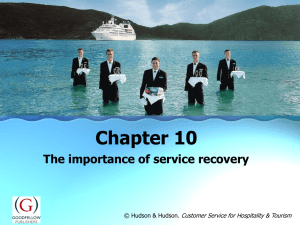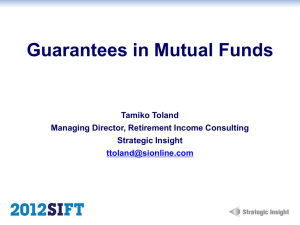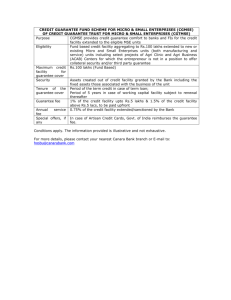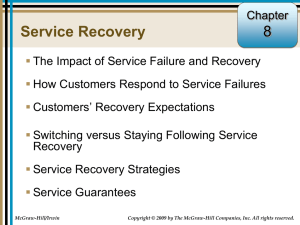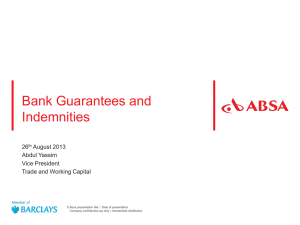Using Guarantees - Habitat for Humanity International
advertisement
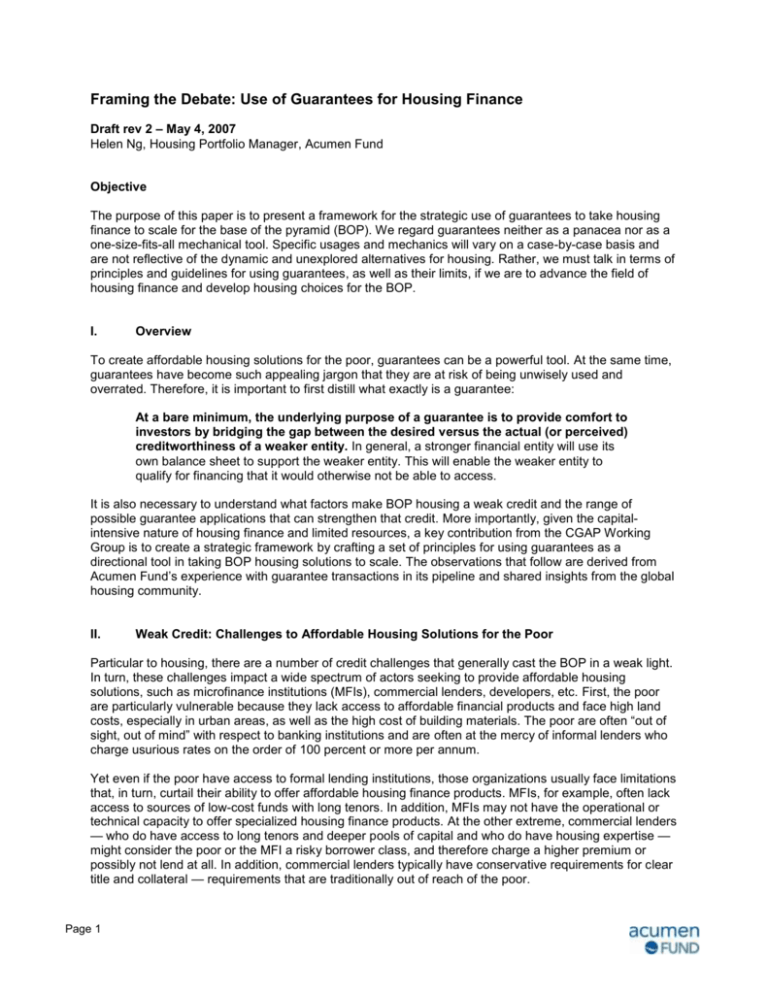
Framing the Debate: Use of Guarantees for Housing Finance Draft rev 2 – May 4, 2007 Helen Ng, Housing Portfolio Manager, Acumen Fund Objective The purpose of this paper is to present a framework for the strategic use of guarantees to take housing finance to scale for the base of the pyramid (BOP). We regard guarantees neither as a panacea nor as a one-size-fits-all mechanical tool. Specific usages and mechanics will vary on a case-by-case basis and are not reflective of the dynamic and unexplored alternatives for housing. Rather, we must talk in terms of principles and guidelines for using guarantees, as well as their limits, if we are to advance the field of housing finance and develop housing choices for the BOP. I. Overview To create affordable housing solutions for the poor, guarantees can be a powerful tool. At the same time, guarantees have become such appealing jargon that they are at risk of being unwisely used and overrated. Therefore, it is important to first distill what exactly is a guarantee: At a bare minimum, the underlying purpose of a guarantee is to provide comfort to investors by bridging the gap between the desired versus the actual (or perceived) creditworthiness of a weaker entity. In general, a stronger financial entity will use its own balance sheet to support the weaker entity. This will enable the weaker entity to qualify for financing that it would otherwise not be able to access. It is also necessary to understand what factors make BOP housing a weak credit and the range of possible guarantee applications that can strengthen that credit. More importantly, given the capitalintensive nature of housing finance and limited resources, a key contribution from the CGAP Working Group is to create a strategic framework by crafting a set of principles for using guarantees as a directional tool in taking BOP housing solutions to scale. The observations that follow are derived from Acumen Fund’s experience with guarantee transactions in its pipeline and shared insights from the global housing community. II. Weak Credit: Challenges to Affordable Housing Solutions for the Poor Particular to housing, there are a number of credit challenges that generally cast the BOP in a weak light. In turn, these challenges impact a wide spectrum of actors seeking to provide affordable housing solutions, such as microfinance institutions (MFIs), commercial lenders, developers, etc. First, the poor are particularly vulnerable because they lack access to affordable financial products and face high land costs, especially in urban areas, as well as the high cost of building materials. The poor are often “out of sight, out of mind” with respect to banking institutions and are often at the mercy of informal lenders who charge usurious rates on the order of 100 percent or more per annum. Yet even if the poor have access to formal lending institutions, those organizations usually face limitations that, in turn, curtail their ability to offer affordable housing finance products. MFIs, for example, often lack access to sources of low-cost funds with long tenors. In addition, MFIs may not have the operational or technical capacity to offer specialized housing finance products. At the other extreme, commercial lenders — who do have access to long tenors and deeper pools of capital and who do have housing expertise — might consider the poor or the MFI a risky borrower class, and therefore charge a higher premium or possibly not lend at all. In addition, commercial lenders typically have conservative requirements for clear title and collateral — requirements that are traditionally out of reach of the poor. Page 1 III. Bridging the Gap: Practical Applications for Guarantees To help overcome some of the challenges faced in the low-income housing sector, some of the purposes toward which guarantees can be used include: Lowering pricing A guarantee may help a borrower access cheaper funding sources than those for which it might otherwise qualify on a standalone basis. For example, if a BB-rated MFI sought funds for a housing finance program, it might be able to access the cheaper rates offered to an AA-rated MFI if accompanied by a guarantee.1 Extending tenor Similarly, a borrower with a guarantee might be able to access funding sources with longer tenors usually by several additional years than it otherwise would on its own status. By stretching out the timeline, the scheduled repayments can be smaller. This will help provide flexibility in sizing financial products to be affordable to the poor. Leveraging a larger pool of capital Housing is capital intensive; however, organizations such as MFIs that traditionally serve the poor generally do not have access to large amounts of capital with low pricing and long tenors. To access this larger pool of capital, MFIs will typically need to borrow from commercial banks and eventually the capital markets. Guarantees and bond wraps 2 might help provide such comfort to more commercially minded co-investors. For example, in an effort spearheaded by Homeless International (UK) and Society for the Promotion of Area Resources Center (SPARC), the Homeless International Guarantee Fund was used to leverage capital resources to finance the Rajiv Indira Suryodaya Project for slum rehabilitation in Mumbai, India. As a result of Homeless International’s $300,000 guarantee to Citibank, the commercial bank was able to lend $1.5 million to SPARC and other local cooperatives in India toward providing permanent housing for SPARC’s members.3 Encouraging banks to go down market Commercial lenders typically have conservative portfolio management requirements. This is because they often need to satisfy national regulatory requirements and maintain a high rating status — an important factor for accessing low-cost funds. However, commercial lenders often regard the lowincome segment as a risky borrower class. Since the habits of the BOP are only beginning to be understood and documented, some of these risk attributes may be perceptions rather than reality. Guarantees therefore might help encourage commercial lenders to go down market by providing a form of “insurance” to protect their overall balance sheet should the portfolio perform below expectations. Substituting traditional collateral Mainstream housing finance generally has been successful in accessing low-cost, long-term financing because housing and particularly land with clear title is a hard asset that can be secured. With an enforceable lien on assets, mainstream housing provides investors with a relatively risk-free investment. However, with BOP housing, access to clear title may be out of reach. Currently, the BOP housing community is exploring different forms of collateral that are accessible to poor consumers and that financiers can gain comfort with. Thus far, the cutting-edge experimentation appears to be with surrogate collateral for home improvement loans. Based on Acumen Fund’s experience investing in the launch of the Home Improvement Loan program of Kashf Foundation4 — Pakistan’s top- 1 While rating agencies use different systems for grading the financial performance of an organizations, they generally adopt similar symbolic systems as those of the major international rating agencies such as Standard and Poor’s (S&P) and Moody’s. For example, S&P's rating scheme uses a letter grade scale that ranges from AAA (highest) to R (lowest), (ie., AAA, AA, A, BBB, BB, B, CCC, R). 2 Bond wraps are guarantees that protect all or part of the repayment stream that bondholders expect to receive. 3 Source: www.sparcindia.org and www.homeless-international.org 4 In 2007, Acumen Fund invested $900,000 in Kashf Foundation to launch their pilot Home Improvement Loan program. Page 2 performing MFI — such proxies can range from providing non-housing assets as security (for example, group guarantees, member escrow accounts, etc.), to psychological collateral (for example, delivery of official documents, list of belongings, etc.). As the market value of this surrogate collateral may be small relative to the borrower’s loan, it will be important to incorporate other product designs that will provide additional comfort to lenders. Bridging reliability of repayment Guarantees also help organizations gain comfort on repayment reliability. For MFIs, group guarantees are a form of both using peer pressure and a pooled economic backstop to help such organizations to better manage the quality of their portfolios. As a result, group guarantees not only are common practice in general loan programs but also continue to be used in housing finance initiatives. In Asia, MFIs such as Grameen (Bangladesh), Kashf (Pakistan), and the Center for Agriculture and Rural Development (CARD, Philippines) require a group guarantee by members for their housing finance products. Similarly Self Employed Women’s Association (SEWA, India) requires co-signers to strengthen the credit of a housing loan for its members. Bridging timing of public subsidies vs. private financing Housing often requires a variety of public and private financing actors and a sequencing of investment phases. One risk with this approach is that the timing at the back end of the sequence may be unreliable and negatively impact financing at the front end. In aggregate, this ultimately increases the cost of housing finance for the poor. A guarantee can bridge the gap in unreliable timing. For example, construction financing is one of the riskiest phases of the housing finance lifecycle, as if often faces unreliable offtake arrangements.5 Although certain public sector programs offer private developers with offtake subsidies to stimulate BOP housing construction, the time to deliver the subsidies may be economically unacceptable to the developer. A guarantee that backs the subsidy may help to bridge that gap and thereby stimulate developer involvement in the public-private program. IV. Principles: Strategic Use of Guarantees A mission of the international housing community is to find ways to help organizations scale up their efforts to serve the poor. In light of the potential power of guarantees and the myriad possible applications, it is important to not lose sight of context and treat the financial tool as a singular mechanical exercise. In service of this mission, the CGAP Working Group appears best poised to lead efforts for affordable housing solutions by framing the dialog on guarantees in terms of principles: To advance housing finance for the poor, it is important to craft a set of principles on the strategic use of guarantees to help take BOP housing to scale. Suggested principles are as follows: 5 Use guarantees as a directional tool — rather than a one-off event — to create the “braces” for eventually tapping the capital markets Setting the dynamic are actors at two extreme ends of the housing finance spectrum: on-the-ground organizations directly serving the BOP (such as MFIs) and commercial lenders that generally do not directly serve the poor. Both are interrelated, so it is important to bridge these extremes for low-cost housing to be successful. For example, given the capital-intensive nature of housing finance, there is a natural directionality built in that will ultimately involve commercial lenders and the capital markets. The challenge, however, is that both actors have different cultures and operate at different levels of sophistication that do not always coincide smoothly. A relatively new MFI may have a sophisticated understanding of the BOP but not the commensurate level of sophistication in financial reporting Offtake refers to purchase agreement. In housing, this might include multi-unit sales contracts and developer-homebuyer arrangements, for example. Page 3 practices that would satisfy commercial lenders. Using guarantees to provide additional comfort to commercial lenders may partly bridge that gap. An example of this “lifecycle” is the experience of Acción International (“Acción”) and MiBanco in Peru. In 1969, Accion established Comunitaria del Perú as a private, non-profit community development organization. In 1998, the non-governmental organization (NGO) transformed to MiBanco and became a regulated financial institution. By 2000, MiBanco was able to formally expand into housing and launched its pilot Micasa home improvement loan. Supporting this growth was the ability by the then-NGO to use guarantees through Accion’s Latin American Bridge Fund 6 to build credit relationships with a local bank as it transitioned from a grassroots organization to a regulated bank. By 2001, MiBanco was able to access a $1.5 million guarantee that backed 50 percent of a $3.0 million credit line from Banco de Crédit, against a Peruvian bank. As Banco de Crédit gained comfort with MiBanco, the portion of the credit line backed by the bridge fund was reduced. By 2003, the guarantee was no longer required. MiBanco could directly access funding through commercial sources.7 The braces should be at least bi-directional to build incremental capacity of both grassroots organizations and commercial lenders If resources are to be mobilized effectively for housing, actors at both ends of the housing finance spectrum will require a shift in traditional practices. However, change does not happen overnight. In particular, this is because such change involves not only a shift in financial operations but also in operational culture, with the latter often taking longer to fully set in. Strategically, therefore, guarantees can be designed as a didactic tool to bridge this operational and cultural divide incrementally. For example, with respect to MFIs, its members are frequently neither familiar with nor comfortable with the commercial practices used in housing finance, such as a lien on assets or provision of official housing documents. Guarantees could be built with incremental performance demands — such as liens on different forms of collateral — of a modest pilot housing microfinance product. This would help the MFI and its members become familiar with the demands they will eventually face when dealing with more commercial-minded investors should the MFI expand the program or create more sophisticated housing products. Conversely, commercial investors generally have little to no experience with the practices of the poor and may not ascribe similar market value to BOP practices. For example, whereas group guarantees are commonly used by MFIs to provide comfort and creditworthiness to an individual borrower, this practice is not necessarily given similar value by commercial investors. A third-party guarantee might help such a commercial lender to gain comfort with the MFI’s practice and encourage them to make accommodations in their established practices to better engage with the low-income borrower. 6 Structuring guarantees should take into account the broad landscape of investors available – from foundations to soft investors to commercial investors Just as there is a wide spectrum of uses for guarantees, there exists a range of investors who could participate in different guarantee types and respond to different risk-reward situations. For example, in the lifecycle of an MFI, as it transitions from a grants-based grassroots organization to a commercially independent finance organization, financial structures and participating actors will also transition. Initial guarantees might come from multilateral donors or foundations, whereas a slightly more mature MFI might require a guarantee with relatively soft terms that would be acceptable to “patient” investors. A more sophisticated MFI might be able to use a guarantee from a commercial lender with more demanding market terms. Alternatively, a guarantee might use a combination of all of these players. ACCION's Latin America Bridge Fund, established in 1984, was the first loan guarantee fund for microfinance institutions. As of 2005, the Latin America Bridge Fund has issued close to $69.3 million to 45 local banks to helped to familiarize the commercial banking sector with the microfinance sector. 7 Cesar Lopez and Jorge de Angulo, “Bridging the Finance Gap: ACCION’s Experience with Guarantee Funds for Microfinance Institutions,” (InSight, Issue No. 15, September 2005). Page 4 Guarantees should not provide unnecessary subsidies or distort the market A caution with guarantees is that, if not used strategically, they might contribute to market distortions and create unintended consequences. For this, we need to pay particular attention to impacts on the macro environment, ranging from potential market competitors to the policy framework of the country, as well as to overall resource allocation. As an example, suppose the policy of a country is to stimulate competition among banks for low-income housing. If all the banks in that country request first loss guarantees8 to encourage them to go down market and if those banks do not take additional risk on their balance sheet, then there is a risk of creating a back-ended subsidy for the bank. While the banks might serve more lower-income groups as a result of the guarantee, it would not be because of additional competition but rather because the banks are able to remain in their comfort zone. At a resource allocation level, this then raises the question of whether or not it makes economic sense to provide such soft money to a bank versus the BOP directly. Corollary: Design guarantees to promote risk sharing and economic viability As a corollary, it is important that incentives be aligned among key stakeholders. This is particularly true of the power and limitations of first-loss guarantee facilities, in which a balance may need to be struck between risk-sharing and economic viability. An example is the risk-sharing structure used for a mortgage guarantee facility that is currently in the final stages of completion for Acumen Fund, the Overseas Private Investment Corporation (OPIC), and the National Bank of Pakistan (NBP). Acumen Fund and OPIC have committed to providing a $5 million guarantee facility to enable NBP to originate up to $50 million of mortgages for lower-income households. NBP will absorb the first loss on the portfolio up to a threshold amount, so that NBP still will have “skin in the game” to develop a quality portfolio. Thereafter, all three parties will share in absorbing the second tier of losses. In this way, the risks and incentives are distributed among all three parties in accordance with their roles. In some cases, such a structure may not be economically feasible for the beneficiary of the guarantee. Let us take the example of a common guarantee structure used by community development finance institutions (CDFIs) in the United States for low-income housing, and more recently MFIs for general loans, that helps lever up capital. A CDFI taps the capital markets by using a bond wrap; the bond wrap helps the organization attain an A rating and therefore provide comfort to capital markets investors. In turn, the bond insurer usually would require a first-loss facility. Ideally, the main stakeholder, the CDFI, should also partake in the first loss to create an alignment of incentives. However, CDFIs may not be in an economic position to contribute to the first loss. In the United States, foundations with aligned missions often provide grants by contributing to the first loss in lieu of the CDFI. Guarantees should not be used as a substitute for a poorly designed product If guarantees are to provide directional momentum to the BOP housing industry, it is important that the underlying product that will serve the poor be thoughtfully conceived and robustly designed. Otherwise, the guarantee would effectively be encouraging a poorly designed program to remain unchanged rather than serving as a building tool to help a well-thought out program reach its potential. Metrics should be incorporated as a design tool Affordable housing for the BOP is an emerging field. In going to scale, it will be important to experiment with and measure terms that will be acceptable to both the BOP and commercial investors. At an early stage in the lifecycle of BOP housing, it would be beneficial to the industry to incorporate a variety of design metrics, ranging from terms within the loan product per se (i.e., minimum income levels, eligibility factors, default rates, etc.) to legal terms within the guarantee itself 8 A first-loss guarantee refers to when a party absorbs the initial loss in a cash flow waterfall. For example, when the repayment stream on a portfolio of mortgages does not perform as well as projected and experiences negative net cash flow, the first loss provider will absorb that loss. This would protect other stakeholders who may have a senior position in the cash flow waterfall relative to the first-loss guarantor. Also, the guarantor may receive some or no compensation for the first loss guarantee. Page 5 (i.e., condition precedents to additional funding, performance covenants, etc.) in order to assess what works and what does not work. These may be useful in the future for follow-on investments or for creating a toolkit or model of desired traits to practitioners. Guarantees must be priced to be cost effective for all parties Guarantee structures can get fairly complicated, and in the process often one forgets to ensure that they are priced to make economic sense to all parties involved. A corollary is that for pilot programs or early-stage initiatives in housing finance, it is sometimes strategically useful to price the guarantee at concessionary rates. This would enable the housing finance product to be relatively inexpensive to attract demand in the early years, thereby helping to provide a safe incubation period for a potentially interesting housing finance program to gestate. It may be possible that once the program is fully launched and can directly access capital at market rates, the housing finance product may be more expensive for the BOP but the product will have been tested and the end user better understood. The success of a guarantee will require consideration of the overall enabling environment Finally, an enabling environment can help to make a guarantee program successful. Key considerations include country policy and enforcement capacity; the presence of ratings agencies; organizational sophistication of grassroots entities, NGOs, and MFIs; and the flexibility and will of commercial lenders to move downmarket. V. Advancing Thought Leadership in the Field As part of the Working Group’s continual efforts to advance the field, other methods in support of the principles to help make guarantees a more understood part of the housing solutions for the poor include: VI. Create case studies to illustrate the financial directionality of guarantees - Study the lifecycle of an organization that goes to scale - Study the lifecycle of an organization that goes downmarket Create case studies on specific guarantee structures and key technical components that illustrate the principles Research the role of guarantees and (surrogate) collateral in BOP housing finance Research metrics and key components that will be important to investors for scaling BOP housing Conclusion This is an exciting time in housing development for the poor. MFIs and formerly grassroots organizations are only beginning to emerge from their localities and crack the capital markets. This is an encouraging sign for housing, but much needs to be learned, discovered and invented to truly broaden the reach of solutions for the BOP. Guarantees will help to play a significant role in this endeavor, and it is hoped that the CGAP Working Group will help serve as a leader in identifying best practices and disseminating those lessons to the international housing community. Page 6
